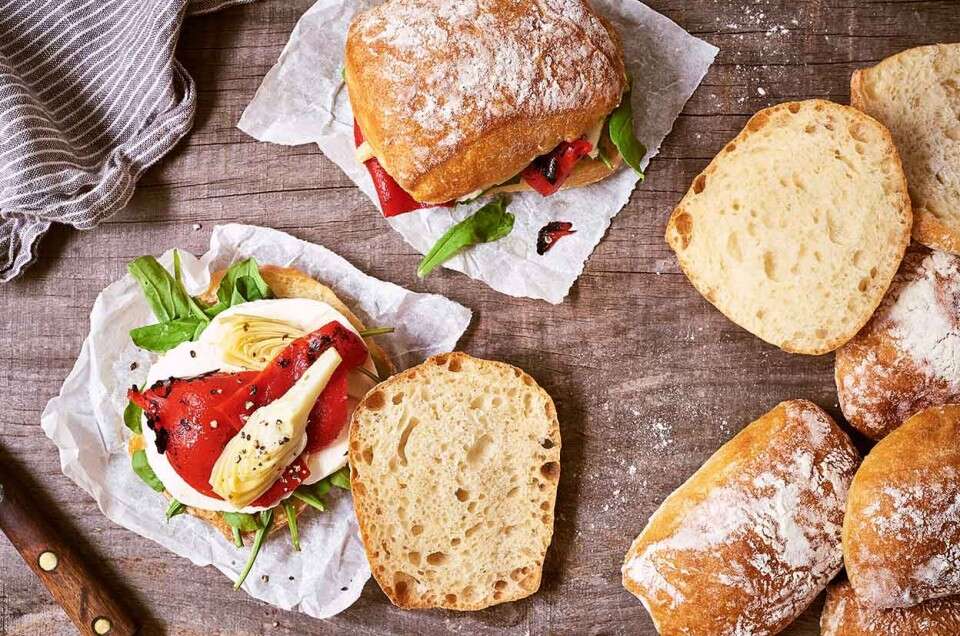Are you looking for the perfect guide to toasting ciabatta bread? You’ve come to the right place! Whether you’re making garlic bread for your family or a grilled cheese sandwich for yourself, nothing beats freshly-toasted ciabatta. Keep reading to learn the best techniques for toasting like a pro.

Table of Contents
Method 1: Oven Toasting
For those of us with ovens, oven-toasting is an excellent method of achieving the perfect toastiness without any fuss.
- Preheat your oven to 350 degrees F
- Put your ciabatta slices on a baking sheet lined with parchment paper or aluminum foil.
- Bake in the oven for 7-10 minutes until desired crispness is achieved.
Method 2: Stovetop Toasting
Stovetop toasting is ideal if you don’t have an oven, or if you just want to get creative with your toast flavorings.
- Heat up a skillet over medium heat and add butter or oil as desired.
- Place your ciabatta slices into the pan – be sure not to overcrowd it!
- Let cook for 3-4 minutes on each side until golden brown and crispy. Once done, remove from heat and season as desired.
Method 3: Toaster Toasting
If you have a standard two-slot toaster at home, then you can use it too!
- Put the ciabatta slices in the slots and adjust settings as needed; generally 5-7 minutes should do the trick!
- For even more flavor, try adding some butter or oil before putting them in the slots.
- The surface of your toast should be lightly browned when done.

FAQs:
Can you freeze ciabatta bread?
Yes, you can freeze ciabatta bread.
To do this, wrap it tightly in aluminum foil or plastic wrap. You can also place the wrapped bread in a freezer-safe bag before freezing it.
When ready to eat, remove the ciabatta from the freezer and thaw on a baking sheet at room temperature.
Once thawed, it will take around 12-15 minutes to heat the bread in a preheated oven set at 350°F.
To get the best results, place the bread on a baking sheet before transferring it to the oven. This will prevent it from getting soggy due to steam buildup while baking.
Is ciabatta bread gluten-free?
The answer to whether ciabatta bread is gluten-free or not depends on the ingredients and how it’s made.
Traditional ciabatta contains wheat, which does have gluten, so it is not a suitable option for those with celiac disease or non-celiac gluten sensitivity.
However, some bakers are now making gluten-free versions of ciabatta using alternative flours such as rice, quinoa, and buckwheat. Before consuming any form of ciabatta bread, it is important to check with the manufacturer or baker to ascertain whether their product is gluten-free.
This will help you to determine if ciabatta can be safely consumed by those with gluten intolerance or sensitivity. It is also important to note that cross-contamination can occur in bakeries, so be sure to ask about their processes for avoiding this as well. Following these tips will help you determine whether ciabatta bread is a safe option for those with gluten sensitivities or celiac disease.
Ensure that you always check with the manufacturer or baker to make sure that their ciabatta bread is gluten-free. If in doubt, ask questions about their ingredients and baking processes to ensure they meet your needs.
Additionally, it’s important to consider potential cross-contamination issues when consuming any form of bakery product, so make sure to ask about their practices in this area as well. By following these steps, you should be able to determine if ciabatta bread can be safely consumed by those with gluten sensitivities or celiac disease.
Read more: The Truth About Ciabatta Bread and Gluten
Is ciabatta bread vegan?
Ciabatta bread is traditionally a vegan-friendly option. It is made from flour, water, yeast, and sea salt, with no animal products or byproducts used in the process.
The only exception might be if your ciabatta contains cheese or other non-vegan ingredients – these should always be checked on the label before purchasing.
Additionally, it’s worth noting that some bakeries may also use butter or other animal products in their ciabatta recipes – so if you’re looking for a vegan option, be sure to check with your local bakery to confirm.
All in all, ciabatta bread can easily become part of a vegan diet with minimal effort.
How to eat ciabatta bread for breakfast?
Ciabatta is a type of Italian white bread which has a light, airy texture and slightly sweet flavor. It’s often served as part of an Italian breakfast or can be used for sandwiches. When eating ciabatta for breakfast, you can enjoy it in several different ways.
One option is to make toast with it. Simply cut a thick slice of ciabatta and place it in the toaster. Toast until golden brown, then spread with butter or your favorite jam or marmalade. Enjoy on its own, or top with scrambled eggs or bacon for a heartier meal.
Another way to enjoy ciabatta is by making French toast. Simply dip pieces of ciabatta in whisked eggs and fry in a skillet until golden brown. Sprinkle with sugar, cinnamon, or nutmeg before serving for added sweetness and flavor.
You can also use ciabatta as part of a breakfast sandwich. Toast two thick slices of ciabatta bread and layer with eggs, bacon, and cheese for a delicious breakfast sandwich.
For something a bit more savory, try topping ciabatta with pesto or olive tapenade. Slice ciabatta in half lengthwise and spread both sides with the desired condiment. Add fresh tomatoes and mozzarella before grilling or baking until the cheese melts.
No matter how you choose to enjoy it, ciabatta bread is a delicious and versatile way to start your day off right. So why not give it a try for breakfast? You’re sure to love it!
Conclusion
No matter which of these methods you choose, you’ll end up with a perfectly crisp ciabatta every time! With its airy texture and light crunchiness, there are so many possibilities when it comes to recipes featuring this delicious bread – from classic garlic bread to fancy Bruschetta recipes, anything goes! So go ahead and experiment with different flavors – who knows what tasty new concoctions await? Bon appétit!
References:
https://www.insider.com/guides/kitchen/types-of-bread
https://cooking.nytimes.com/recipes/1015532-ciabatta









